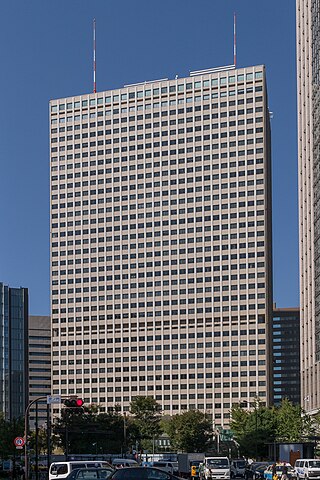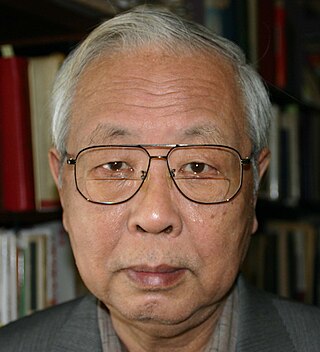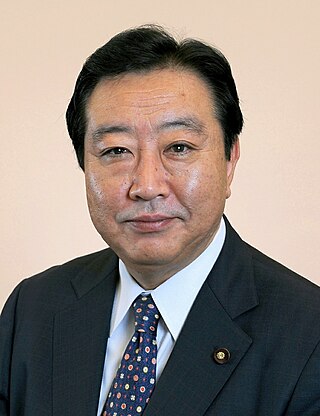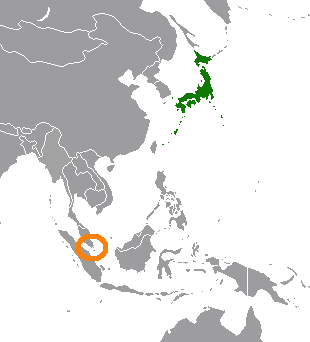
Japan is an island country in East Asia. It is in the northwest Pacific Ocean and is bordered on the west by the Sea of Japan, extending from the Sea of Okhotsk in the north toward the East China Sea, Philippine Sea, and Taiwan in the south. Japan is a part of the Ring of Fire, and spans an archipelago of 14,125 islands, with the five main islands being Hokkaido, Honshu, Shikoku, Kyushu, and Okinawa. Tokyo is the country's capital and largest city, followed by Yokohama, Osaka, Nagoya, Sapporo, Fukuoka, Kobe, and Kyoto.

The Japan Times is Japan's largest and oldest English-language daily newspaper. It is published by The Japan Times, Ltd., a subsidiary of News2u Holdings, Inc. It is headquartered in the Kioicho Building in Kioicho, Chiyoda, Tokyo.

The Japanese diaspora and its individual members, known as Nikkei (日系) or as Nikkeijin (日系人), comprise the Japanese emigrants from Japan residing in a country outside Japan. Emigration from Japan was recorded as early as the 15th century to the Philippines, but did not become a mass phenomenon until the Meiji period (1868–1912), when Japanese emigrated to the Philippines and to the Americas. There was significant emigration to the territories of the Empire of Japan during the period of Japanese colonial expansion (1875–1945); however, most of these emigrants repatriated to Japan after the 1945 surrender of Japan ended World War II in Asia.

The Nippon Sei Ko Kai, abbreviated as NSKK, sometimes referred to in English as the Anglican Episcopal Church in Japan, is the national Christian church representing the Province of Japan within the Anglican Communion.

Kasumigaseki is a district in Chiyoda Ward in Tokyo, Japan. It is the location of most of Japan's cabinet ministry offices. The name is often used as a metonym for the Japanese government bureaucracy, while Nagatachō refers to the elected government or the legislative branch. Kasumigaseki Station was one of the stations affected during the Tokyo subway sarin attack.
The Sankei Shimbun, name short for Sangyō Keizai Shinbun, is a daily national newspaper in Japan published by the Sankei Shimbun Co., Ltd, ranking amongst the top 5 most circulated newspapers in Japan.

Japantown (日本人街) is a common name for Japanese communities in cities and towns outside Japan. Alternatively, a Japantown may be called J-town, Little Tokyo or Nihonmachi (日本町), the first two being common names for Japantown, San Francisco, Japantown, San Jose and Little Tokyo, Los Angeles.
A kisha club is a Japanese news-gathering association of reporters from specific news organizations, whose reporting centers on a press room set up by sources such as the Prime Minister's Official Residence, government ministries, local authorities, the police, or corporate bodies. In English, it also called a Press Club.

Ikuhiko Hata is a Japanese historian. He earned his PhD at the University of Tokyo and has taught history at several universities. He is the author of a number of influential and well-received scholarly works, particularly on topics related to Japan's role in the Second Sino-Japanese War and World War II.
Tokyo Journal is an English-language quarterly magazine about Tokyo and Japan, which was established in 1981.

Yōichi Masuzoe is a Japanese politician who was elected to the position of governor of Tokyo in 2014 and resigned in June 2016 due to the misuse of public funds. He was previously a member of the Japanese House of Councillors and the Japanese Minister of Health, Labor, and Welfare. Before entering politics, he became well known in Japan as a television commentator on political issues.

Yoshihiko Noda is a Japanese politician who served as Prime Minister of Japan and Leader of the Democratic Party of Japan from 2011 to 2012. He is a member of the Constitutional Democratic Party of Japan, and a member of the House of Representatives in the Diet. He was named to succeed Naoto Kan as a result of a runoff vote against Banri Kaieda in his party, and was formally appointed by the Emperor Akihito on 2 September 2011.

General elections were held in Japan on 16 December 2012. Voters gave the Liberal Democratic Party a landslide victory, ejecting the Democratic Party from power after three years. It was the fourth worst defeat suffered by a ruling party in Japanese history.
Francesco Bellissimo is an Italian celebrity chef, actor, foreign tarento, social media personality, businessman, martial artist and sommelier dell'Olio. He holds the rank of 3rd dan black belt in Kyokushin karate. He is living and working in Japan, and nicknamed Italia no Taneuma and Italia Ryori no Kyosho. He is the president of the Italian Cooking Association in Japan, known as "Italian Ryouri Kenkyukai" in Japanese. In a survey he was found to be the second most famous Italian in Japan after Giorgio Armani.

Cool Japan refers to the aspects of Japanese culture that non-Japanese people perceive as "cool". After the success of "Cool Britannia," the Japanese government started using the phrase. The Cool Japan strategy is part of Japan's overall brand strategy, aiming to disseminate Japan's attractiveness and allure to the world. The target of Cool Japan "encompasses everything from games, manga, anime, and other forms of content, fashion, commercial products, Japanese cuisine, and traditional culture to robots, eco-friendly technologies, and other high-tech industrial products".

Contemporary Japan: A Review of Far Eastern Affairs was a quarterly Japanese English-language magazine published between 1932 and 1970 by the Foreign Affairs Association of Japan.

Japan–Somalia relations are bilateral relations between Japan and Somalia. Japan has a non resident ambassador in Nairobi.
Nippon Kaigi is Japan's largest ultraconservative and ultranationalist far-right non-governmental organization and lobbying group. It was established in 1997 and has approximately 38,000 to 40,000 members as of 2020.

Kodansha Ltd. is a Japanese privately held publishing company headquartered in Bunkyō, Tokyo. Kodansha publishes the manga magazines Nakayoshi, Afternoon, Evening, Weekly Shōnen Magazine, and Bessatsu Shōnen Magazine, as well as the more literary magazines Gunzō, Shūkan Gendai, and the Japanese dictionary Nihongo Daijiten. Kodansha was founded by Seiji Noma in 1910, and members of his family continue as its owners either directly or through the Noma Cultural Foundation.

Japan–Singapore relations or Singapore–Japan relations refers to the bilateral relations between Japan and Singapore, two highly developed Asian countries which share historical, economic, and political ties. While the two countries first established bilateral relations in 1966, some of the earliest relations date back from before the 15th century during the Muromachi period as well as the Ryukyu Kingdom. This continued for centuries until the most notable interaction with Japan's invasion of Singapore during World War II. The invasion led to a takeover of the country, after which Japan occupied Singapore for approximately four years before withdrawing following their loss in the war.















